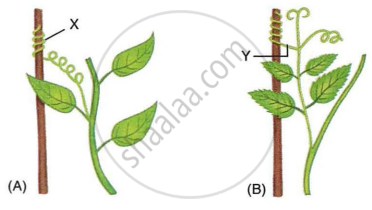Advertisements
Advertisements
Questions
Distinguish between tropic movements and nastic movements in plants. Give examples to illustrate your answer.
How do tropisms differ from nasties (or nastic movements)?
Solution 1
| Tropic movements | Nastic movements |
| These are directional movements of plants in response to stimulus. | These are non-directional movements of plants in response to stimulus. |
| Example: The upward growth of a plant stem in response to sunlight. | Example: The folding up of leaves in response to touch. |
Solution 2
| Tropism | Nasties |
| Tropisms are the directional movement of plant parts in response to an external stimulus. | Nasties are the non-directional movements of plant parts in response to an external stimulus. |
APPEARS IN
RELATED QUESTIONS
How do auxins promote the growth of a tendril around a support?
What is a plant hormone? Name four plant hormones. State one function of each.
What does a tendril do in response to the touch of a support? What is this phenomenon known as?
The chemical substance P is made and secreted by the meristematic tissue at the tip of stem (or shoot) of a plant. The chemical substance P is responsible for a phenomenon Q in plants in which the stem bends towards a source of light. The same chemical substance P has an opposite effect on the root of a plant. It causes the root of a plant to bend away from the source of light in a process called R.
(a) What is the chemical substance P?
(b) State whether P prefers to remains in the sunlit side of a stem or in shade.
(c) What is the effect of substance P on the rate of growth of (i) a root, and (ii) a stem?
(d) What is the name of process (i) Q, and (ii) R?
(e) What is the general name of chemical substances like P? Name another substance which belongs to this class of chemical substances.
With the help of an experiment, prove that roots are more positively hydrotropic than geotropic.
State whether true or false. If false, correct the statement.
The response of a part of plant to the chemical stimulus is called phototropism.
The Scientific term used to represent the bending of roots toward water is called geotropism.
What does a Mimosapudica plant do in response to touch? What is the phenomenon known as?
Name the stimulus which causes the following movement in plant:
phototropism
Study the diagrams given below and answer the following questions:

- Name the structures shown as X and Y in the figures (A) and (B), respectively.
- Write the functions performed by the structures X and Y.
- Name the phenomenon depicted and define it.
- How do the structures X and Y differ from each other?
- Give examples of the plants which show the said phenomenon.
